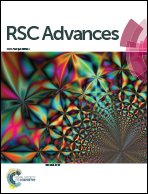Electricity generation by biocathode coupled photoelectrochemical cells†
Abstract
Biocathode coupled photoelectrochemical cells (Bio-PEC) have the potential for electricity generation and pollutant removal, with the simultaneous utilization of both solar energy and bioenergy. However, their performance is influenced by many factors. In this work, crucial parameters, including the pollutant type, electrolyte concentration and gas atmosphere of the photoanode, were investigated to optimize the operation of the Bio-PEC in terms of electricity generation.


 Please wait while we load your content...
Please wait while we load your content...